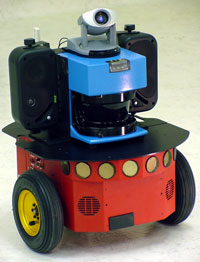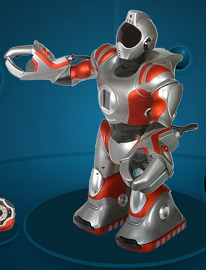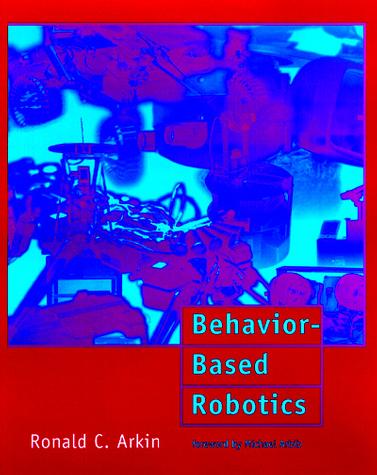
CS 790 (X) Seminar in Robotics
|

 |
|
 |
|
Instructor: Monica Nicolescu |
||||||||
|
||||||||
Time and Place |
||||||||
| Tuesday, Thursday: 1:00pm-2:15pm; WRB 4051 | ||||||||
Recommended Textbooks |
||||||||
| There is no required textbook for
this course. The books below constitute a good source of additional
background and in-depth readings on topics relevant to the course.
|
||||||||
| The Robotics Primer, 2007. Author: Maja Mataric' |
 |
|||||||
| Springer Handbook of Robotics, 2008. Editors: Bruno Siciliano, Oussama Khatib |
 |
|||||||
| Behavior-Based Robotics, 2001. Author: Ron Arkin |
 |
|||||||
Course description |
| This is an advanced level, seminar-style course, which will
examine representative approaches to robot control, learning, coordination
and cooperation between multiple robots and human-robot interaction.
Students will learn about the development of the robotics field and the main
directions of research in this area. Each week all the students will read all of the assigned readings. Each
of the assigned readings will be presented by a student, and discussed and
critiqued by all others.
|
Prerequisites |
| CPE 470-670 (Autonomous Mobile Robots) or CS 476/676 (Artificial Intelligence). Good programming skills are essential. If you have not taken any of these classes you should purchase "The Robotics Primer" book for background reading. |
Project |
| Each student will complete an individual research project,
on a topic covered in class. Teams up to two students are possible, however the complexity of the selected topic
must justify it. Project topics: The projects should be an implementation of either: a single robot system (involving complex behavior and demonstrated on a physical robot) or a multi-robot system (involving cooperation/communication/coordination between robots and demonstrated in simulation). Test-beds: The following simulation environments and physical robots will be available for the project:
Project report: For each project students should prepare a final project report, which should include the following:
Timeline: The project development should adhere to the following timeline:
The final project report and the project status report should be formatted using the style format for IEEE Transactions publications found at: http://www.ieee.org/web/publications/authors/transjnl/index.html (use the templates under the "Template for all Transactions (except IEEE Transactions on Magnetics)" section). |
Syllabus |
| Following are the topics that will be discussed, listed in the approximate order in which they will be covered. |
|
Class schedule |
|
Paper reports: During each lecture we will discuss a numbers of papers on a specific research topic. Students must read the papers before class and submit, for each of the papers presented that day, a brief report for each paper. The reports should be submitted at the beginning of the class when they are discussed and must contain:
All reports should be typed - no hand-written reports will be accepted. Paper presentations: During the semester, each student is required to present several papers to the rest of the class. Each presentation should take about 25-30 minutes and must be prepared as if presented in a formal conference (i.e., slides, projector). This presentation should assume that the audience has read the paper, and not spend more than about 15 minutes summarizing it. The rest of the presentation should be spent on discussing the paper, its strengths, weaknesses, any points needing clarification. The presentation will be followed by class discussions in which all students will express their point of view and general comments on the paper. The table below presents the tentative schedule of assigned readings. |
| Date | Topic | Papers | Presentations |
|
Jan 20 |
Introduction (part 1) | Monica | |
|
Jan 22 |
Introduction (part 2) | Monica | |
|
Jan 27 |
Robotic architectures | Chapter 8: Robotic Systems Architectures and Programming (Springer Handbook) | Dritan |
|
Jan 29 |
Reactive and hybrid architectures | "A Robust Layered Control System for a Mobile Robot", Rodney Brooks, MIT AI Lab Technical Report, Sept. 1986. | Mohammad |
| "Attention to Action: Willed and Automatic Control of Behavior", Donald A. Norman, Tim Shallice, in Consciousness and Self-Regulation: Advances in Research and Theory, vol. 4, Eds. R. Davidson, G. Schwatz, and D. Shapiro, pages 1-17, 1986. | Siming | ||
|
Feb 3 |
Behavior-based systems | Chapter 38: Behavior-Based Systems (Springer Handbook) | Luke |
|
Feb 5 |
Colloquia | Attend colloquia talk on February 6, noon-1pm in DMSC 102 | |
|
Feb 10 |
Colloquia | Attend colloquia talk on February 10, noon-1pm in DMSC 102 | |
|
Feb 12 |
Behavior-based systems | "Integration of Representation Into Goal-Driven Behavior-Based Robots", Maja J Mataric´, IEEE Transactions on Robotics and Automation, 8(3), pages 304-312, June 1992. | Alex |
| "Model-Free Execution Monitoring in Behavior-Based Robotics, O. Pettersson, L. Karlsson, A. Saffiotti: IEEE Transactions on Systems, Man, and Cybernetics, Part B: Cybernetics 37(4), pages 890 - 901, 2007. | Dritan | ||
|
Feb 17 |
Colloquia | Attend colloquia talk on February 13, noon-1pm TBD | |
| Feb 19 | Visual sensing | Chapter 63: Perceptual Robotics (Springer Handbook) | Alex |
|
Feb 24 |
Colloquia | Attend colloquia talk on February 18, noon-1pm TBD | |
|
Feb 26 |
Project proposals | Proposal presentations | |
|
Mar 3 Room change SEM 246 |
Sensing and perception | A behavioral analysis of robotic models of visual attention. International Journal of Computer Vision, F. Shic & B. Scassellati, Vol. 73(2), p. 159-177, 2007. | Luke |
| "Learning Object Affordances: From Sensory-Motor Coordination to Imitation", Luis Montesano, Manuel Lopes, Alexandre Bernardino, and Jose Santos-Victor, IEEE Transactions in Robotics, Vol. 24, No. 1, 2008. | Dritan | ||
|
Mar 5 |
Learning by demonstration | Chapter 59: Robot Programming by Demonstration (Springer Handbook) | Siming |
|
Mar 10 |
Robot learning by demonstration | "Using perspective taking to learn from ambiguous demonstrations", Cynthia Breazeal, Matt Berlin, Andrew Brooks, Jesse Gray, Andrea L. Thomaz, Robotics and Autonomous Systems, Vol.54, pages 385–393, 2006. | Alex |
| "Confidence-Based Multi-Robot Learning from Demonstration", Sonia Chernova, Manuela Veloso, International Journal of Social Robotics, 2:195--215, 2010. | Luke | ||
| Mar 12 | Mapping and localization | Chapter 37: Simultaneous Localization and Mapping (Springer Handbook) | Mohammad |
| Mar 24 | Navigation and mapping | "Sonar-Based Real-World Mapping and Navigation", Alberto Elfes, IEEE Journal of Robotics and Automation, Vol. 3, pages 249-265, 1987. | Dritan |
| "Semantic Mapping Using Mobile Robots", Denis F. Wolf and Gaurav S. Sukhatme, IEEE Transactions on Robotics, Vol. 24, No.2, pages 245-258, 2008. | Siming | ||
|
Mar 26 |
Multi-robot systems | Chapter 40: Multiple Robot Systems (Springer Handbook) | Mohammad |
| Mar 31 | Multi-robot systems | "Experiments with a large heterogeneous mobile robot team: exploration, mapping, deployment and detection", Andrew Howard, Lynne Parker, Gaurav Sukhatme, International Journal of Robotics Research, Vol. 25, No. 5-6, May, June 2006, pages 431-447. | Mohammad |
| "Safe multirobot navigation within dynamics constraints", James R. Bruce and Manuela M. Veloso, Proceedings of the IEEE, Vol, 94, No. 7, July 2006, pages 1398-1411. | Luke | ||
| Apr 2 | Distributed robotics | Chapter 41: Networked Robots (Springer Handbook) | Alex |
| Apr 7 | Distributed robotics | "A distributed algorithm for 2D shape duplication with smart pebble robots", Kyle Gilpin and Daniela Rus, Proceedings of the IEEE International Conference on Robotics and Automation, ICRA 2012, pages 3285-3292. | Mohammad |
| "Emulating Self-reconfigurable Robots - Design of the SMORES System", Jay Davey, Ngai Kwok, and Mark Yim, Proceedings of the 2012 IEEE/RSJ International Conference on Intelligent Robots and Systems October 7-12, 2012. | Luke | ||
| Apr 9 | Humanoid robotics | Chapter 56: Humanoids (Springer Handbook) | Dritan |
| Apr 14 | Humanoid robotics | ""Social Robots as Embedded Reinforcers of Social Behavior in Children with Autism", E. S. Kim, L. D. Berkovits, E. P. Bernier, D. Leyzberg, F. Shic, R. Paul, & B. Scassellati, Journal of Autism and Developmental Disorders, 2012. | Alex |
| "Learning of Grasp Selection based on Shape-Templates", Herzog, A.; Pastor, P.; Kalakrishnan, M.; Righetti, L.; Bohg, J.; Asfour, T.; Schaal, S., Autonomous Robots, 2013. | Mohammad | Apr 16 | Projects | Project status presentations |
|
Apr 21 |
Social robotics | Chapter 58: Social Robots that Interact with People (Springer Handbook) | Luke |
| Apr 23 | Social robotics | "Who is IT? Inferring Role and Intent from Agent Motion", Christopher Crick, Marek Doniec Brian Scassellati, Proceedings of the 6th IEEE International Conference on Development and Learning (ICDL 2007), London, England, July 2007. | Alex |
| "Cost-Based Anticipatory Action Selection for Human–Robot Fluency", Guy Hoffman and Cynthia Breazeal, IEEE Transactions on Robotics, Vol. 23, No. 5, pages 952-961, 2007. | Dritan | ||
| Apr 28 | Student selected papers. | "On-Board Object Tracking Control of a Quadcopter with Monocular Vision", Alex G. Kendall, Nishaad N. Salvapantula, Karl A. Stol, 2014 International Conference on Unmanned Aircraft Systems (ICUAS) May 27-30, 2014. Orlando, FL, USA. | Alex |
| "Introducing Belbic: Brain Emotional Learning Based Intelligent Controller", Caro Lucas, Danial Shahmirzadi and Nima Sheikholeslami, Intelligent Automation & Soft Computing Volume 10, Issue 1, 2004, pages 11-21. | Mohammad | ||
| May 5 | Student selected papers. | Paper 1. | |
| Paper 2. | |||
May 12 5:00-7:00pm |
Project final presentations and demonstrations. | Location: SEM 201 | |
Assignments and grading |
||||||||||||||||||
| Evaluation for this class will be based on your paper
presentations, participation in class discussions, summary reports for each
of the papers and a final project. Regular class participation is required.
Grading policy (tentative, subject to change):
Late policy: No late submissions will be accepted. Academic integrity: Students are encouraged to study together, however each student must individually prepare his/her solutions. Cheating or plagiarism are not permitted and will be sanctioned according with the UNR policy on Academic Standards. You should carefully read the section on Academic Dishonesty found in the UNR Student Handbook (copies of this section are on-line). Your continued enrollment in this course implies that you have read it, and that you subscribe to the principles stated therein.
|